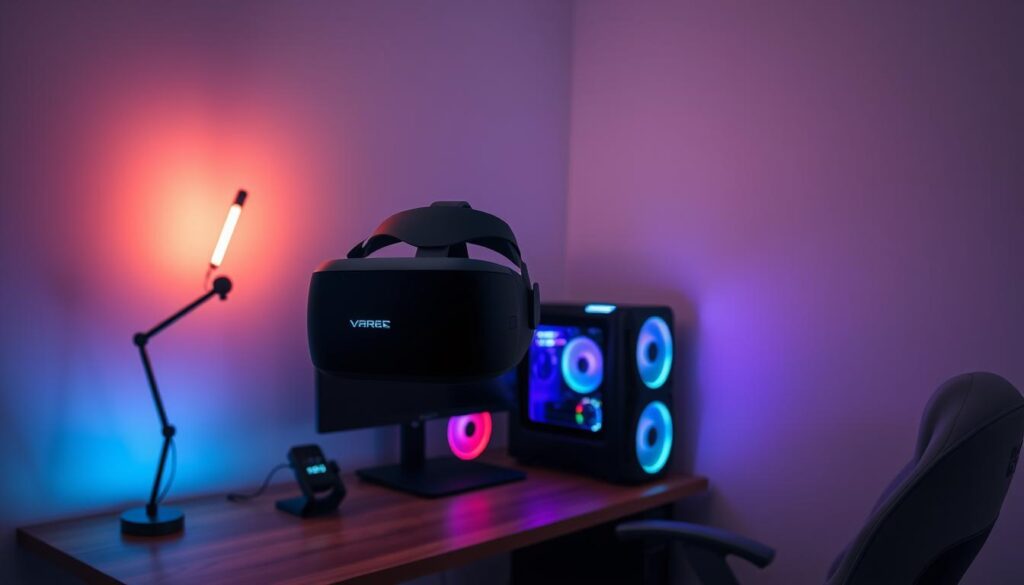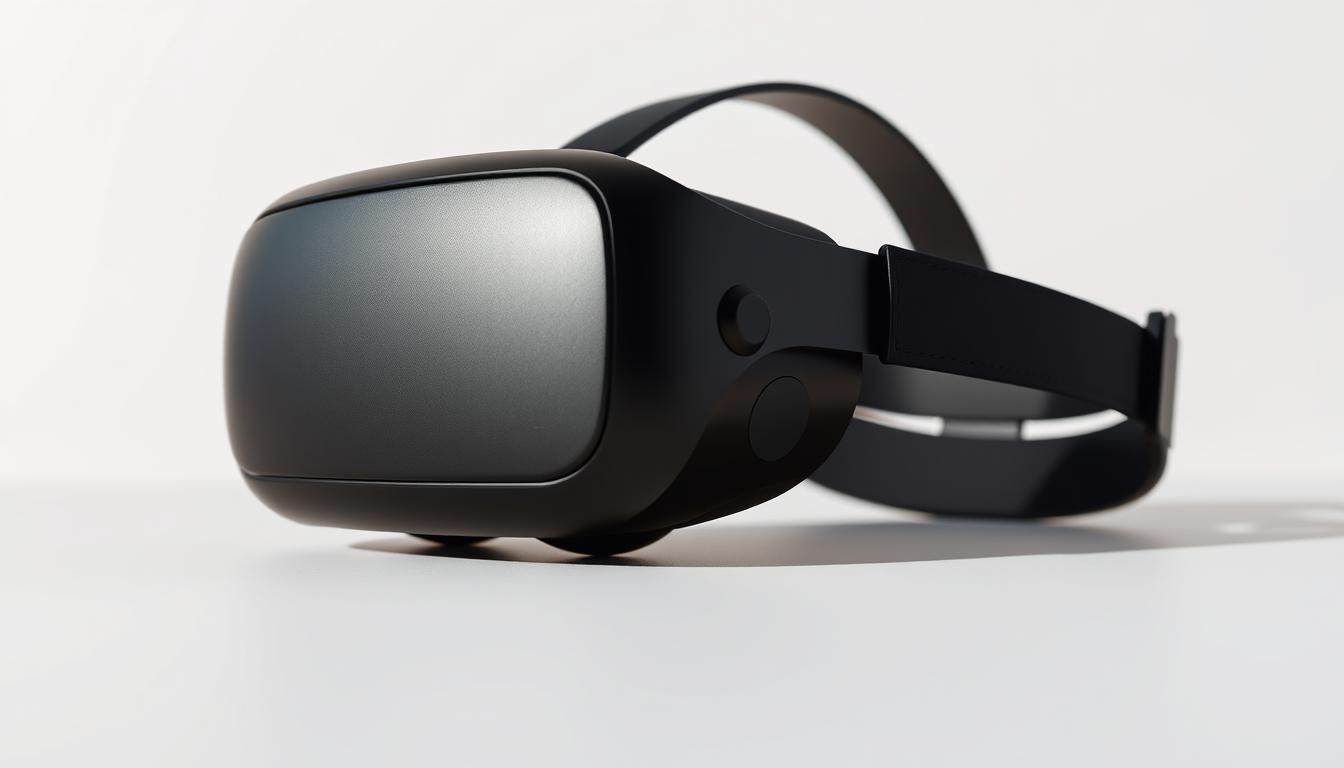Are you tired of complicated VR setups? Do you want to dive into immersive virtual worlds easily? Now, you can with just a single headset and no extra tracking equipment.
The world of virtual reality has changed a lot. Inside-out tracking VR technology has made it easier. Now, headsets like Meta Quest 3 can set up without extra sensors, making VR more accessible.
Today’s top VR headsets use built-in cameras and sensors. They track your movements well. This means you can set up VR quickly, without needing extra hardware.
Key Takeaways
- Modern VR headsets can track movements without external sensors
- Inside-out tracking provides more flexibility in room setup
- No additional hardware required for basic VR experiences
- Simplified installation process for beginners and experienced users
- Enhanced mobility and ease of use compared to traditional VR systems
Introduction
Virtual reality has changed how we see digital worlds. The growth of VR tracking tech has made it easier and more fun to dive into these worlds.
The Advantages of Inside-Out Tracking
Inside-out tracking is a big step forward in wireless VR tech. It uses cameras and sensors in VR headsets to track movement and position in 3D space.
- Eliminates the need for external base stations
- Simplifies setup process
- Improves overall portability
- Reduces system complexity and cost
How Sensor-Free VR Headsets Work
Modern VR headsets use cool tech for smooth motion tracking. Standalone VR setups have many parts to make sure you’re in the right spot:
| Component | Function |
|---|---|
| Onboard Cameras | Capture room environment and track movement |
| Gyroscopes | Measure rotational movements |
| Accelerometers | Track linear acceleration and tilting |
| Advanced Algorithms | Process sensor data for precise tracking |
“The future of VR is sensor-free, providing users with unprecedented freedom of movement.” – VR Technology Experts
These tech upgrades mean VR gaming is now more real and fun. You can play without a big setup hassle.
Choosing the Right VR Headset

Finding the perfect VR headset can be tough with so many choices. Your pick depends on several important factors that affect your VR experience. Experts say to look at many when picking the best standalone VR setups.
Top Standalone VR Headsets
Looking for the best sensorless VR headsets, you’ll find a few top picks:
- Meta Quest 3: Offers top wireless VR tracking solutions
- Meta Quest 3S: A budget-friendly way into standalone VR
- PlayStation VR 2: A high-quality choice for console gamers
Pros and Cons of Sensor-Free VR
Knowing the good and bad of standalone VR is key:
| Advantages | Potential Limitations |
|---|---|
| Easy VR space setup without sensors | Occasional tracking accuracy challenges |
| Wireless mobility | Limited precise movement tracking |
| Lower initial investment | Less complex tracking compared to external sensor systems |
Pro tip: When setting up Oculus Quest, make sure your play area is clear and well-lit for the best results.
The future of VR is wireless, portable, and getting easier for everyone.
Setting Up Your Play Area

Creating the perfect VR space is key for a great experience. Your play area affects how well VR headset tracking methods work. Knowing how to improve VR tracking can make your virtual reality better.
Preparing Your Virtual Environment
When setting up standalone VR, remember these important points:
- Clear 6-8 feet of open space
- Remove tripping hazards
- Ensure consistent lighting
- Avoid direct sunlight or reflective surfaces
Lighting and Tracking Precision
Good lighting is key for inside-out tracking. Rooms that are too bright or too dark can mess up tracking. Soft, even light keeps tracking steady.
Pro Tip: Use neutral-colored walls and consistent room lighting to enhance VR tracking performance.
Configuring Tracking Settings
Most VR headsets let you adjust tracking settings. Look through your device’s settings to tweak:
- Guardian boundary setup
- Controller sensitivity
- Room mapping precision
- Movement tracking zones
By getting your space ready and learning about VR tracking, you’ll have a top-notch virtual reality setup.
Troubleshooting Common Issues
![]()
Virtual reality tech keeps getting better, but sometimes it has tracking problems. Knowing how to fix VR tracking can make your experience much better.
Fixing Tracking Errors Without Sensors
Here are some tips for fixing VR tracking issues:
- Recalibrate your VR controllers by placing them on a flat surface
- Clear any obstructions near the headset’s tracking cameras
- Restart your VR system to reset tracking parameters
Improving VR Accuracy in Low-Light Environments
VR tracking can be tough in low light. Here are some ways to keep tracking sharp:
- Add subtle ambient lighting to your VR space setup without sensors
- Use bright, consistent background colors
- Ensure clean camera lenses on your best standalone VR setups
“Consistent lighting is the key to seamless VR tracking performance.” – VR Technology Experts
Pro tip: Check your headset’s specific low-light tracking capabilities to maximize your VR experience.
Conclusion
Virtual reality is changing how we interact with digital worlds. Setting up VR without sensors is now easier than ever. Wireless VR tracking solutions make it simple to dive into virtual spaces.
The latest VR headsets let you move freely without sensors. New tech has made tracking more accurate and easy to carry. Now, you can jump into virtual worlds quickly and easily.
VR is getting even better with new tracking tech on the way. Companies are working hard to make systems that feel natural and easy to use. They want to make VR experiences that feel real and smooth.
Your VR adventure is just starting. With better tracking tech, the line between real and virtual worlds is getting smaller. Dive into the new world of VR and see what’s waiting for you.
FAQ
What is inside-out tracking in VR?
Do I need a special room setup for a sensor-free VR headset?
What are the main advantages of inside-out tracking?
Can inside-out tracking work in low-light environments?
What should I do if my VR headset loses tracking?
Which VR headsets have the best inside-out tracking?
How accurate is inside-out tracking compared to external sensor systems?
Do I need to calibrate my VR headset frequently?
Source Links
- Circuit Stream · All You Need to Know About Oculus Link
- Setting up a VR space
- Virtual reality (VR) | Definition, Development, Technology, Examples, & Facts | Britannica
- Exploring VR User Experiences – Technology, Knowledge and Learning
- The ultimate VR headset buyer’s guide
- How to choose your VR Headset?
- Best VR Headset of 2025
- Loka: A Cross-Platform Virtual Reality Streaming Framework for the Metaverse
- The best VR headsets for 2025
- COMPUTER SCIENCE & ENGINEERING
- Effect of a home-based physical rehabilitation program via virtual reality on the functional outcomes of frail older adults: a quasi-experimental study
- Mixed Reality Outperforms Virtual Reality for Remote Error Resolution in Pick-and-Place Tasks
